Editor’s note: This article first appeared in the March/April issue of LDS Living magazine.
Art conveys spiritual truths in ways that words cannot. Paintings can express feelings, messages, and principles that are universally understood—no matter your language, culture, or life experiences. For these five artists, depicting Jesus Christ is a powerful way to share testimony and dive deeper into His divine, profoundly personal role in our lives.
Tyrone Whitehorse: The Savior to all Nations

Painting the Savior has increased Tyrone Whitehorse’s understanding of the abiding love Christ feels for all of God’s children.
Tyrone grew up in the Navajo Nation around Page, Arizona, and currently lives in Provo, Utah. When a local art gallery sent out a call for more diverse paintings of the Savior, he felt an urgency to share how his cultural perspective informs his testimony of Christ.
“Diversifying images of the Savior broadens our perspective on who the Savior is and how He works among the people on this earth,” Tyrone says.
He spent almost a year reflecting on how to depict Christ. As the gallery deadline approached, however, a distinct image came to his mind almost immediately.
In Navajo culture, people create tribal blankets to differentiate their head leaders. “The colonizer would call them ‘chiefs,’” Tyrone says. “The head people would wear these blankets to signify their authority in their tribe. If Christ were to come to us today, I could imagine Him wearing something like that to differentiate Himself to us, that He is our Leader, that He’s the Creator, that He’s the Savior to all nations.”
Tyrone acknowledges the complex history surrounding colonization, Indigenous peoples, and Christianity, but he finds peace in the Savior’s true character. “Native people have often felt marginalized and outside of the group because Christianity became more of a subjector role to Native American people rather than a salvation role,” he says. “When you really come to know the Savior, you come to realize and understand who He is. He’s a Savior to all of us—to the marginalized and to us as Native people as well.”
Tyrone’s painting The Savior to All Nations features a purple background to signify Christ’s royal birth. Tyrone also included the Medicine Wheel, a symbol common to many Native nations in the Northern Hemisphere that represents teachings of peace, prosperity, and harmony.

“Those colors in the Medicine Wheel represent how we are all supposed to live in harmony and peace and love with each other,” he says. “I believe that comes full circle because that teaching would have originated from Him.”
While the idea for the image came overnight, Tyrone hopes the painting’s impact will last much longer, reminding people of the Savior’s expansive compassion and invitation to love one another as He loves us.
“It’s a sacred responsibility to take on the task of painting the Savior,” he says. “In painting Him, I’ve not only come to see inside my own heart but also to begin to see others the way that He sees them, which is from a place of love.”
Chrisanne Serafin: He Carries Our Burdens
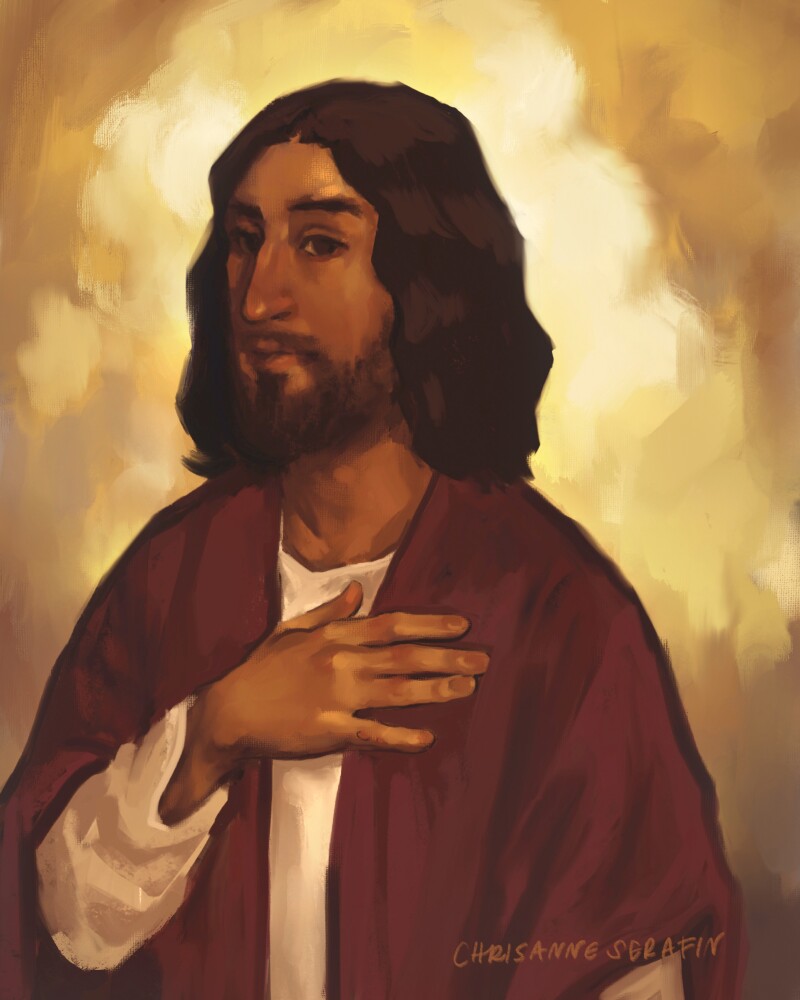
Just as He is the Savior to all groups and nations, Jesus Christ knows how to help us individually according to our challenges and infirmities.
Painting Christ became a lifeline for North Carolina-based artist Chrisanne Serafin as she navigated months filled with what she describes as “some of the lowest mental and emotional lows I’ve had in years.” Trying to balance these challenges while taking care of her four young children left her feeling overwhelmed and unable to shoulder her burdens alone.
Her husband, family, and friends supported her with housekeeping and parenting tasks, but she found she needed to turn to Christ more than ever before to find hope and relief. She poured her feelings into an image inspired by a phrase from Isaiah 53:4: “Surely he hath borne our griefs, and carried our sorrows.”
“When I was painting the Savior specifically, my mind was more open to Him, and I wasn’t focused on all the anxiety and other issues I was having,” Chrisanne says. “[As I paint,] I’m focused on trying to portray these feelings and ideas that I have about Him, which naturally leads to thinking about Him more.”
Keeping her hands busy quieted her mind, and she was able to surrender the weight of her burdens and commune with the Spirit to come closer to Christ.
“I was able to both connect ideas that I had of Him visually and also ideas that I had of Him spiritually and dwell more on His humanity and His mortal experience—and the way that going through that journey and that experience has allowed Him to succor us in our difficulties,” she says.
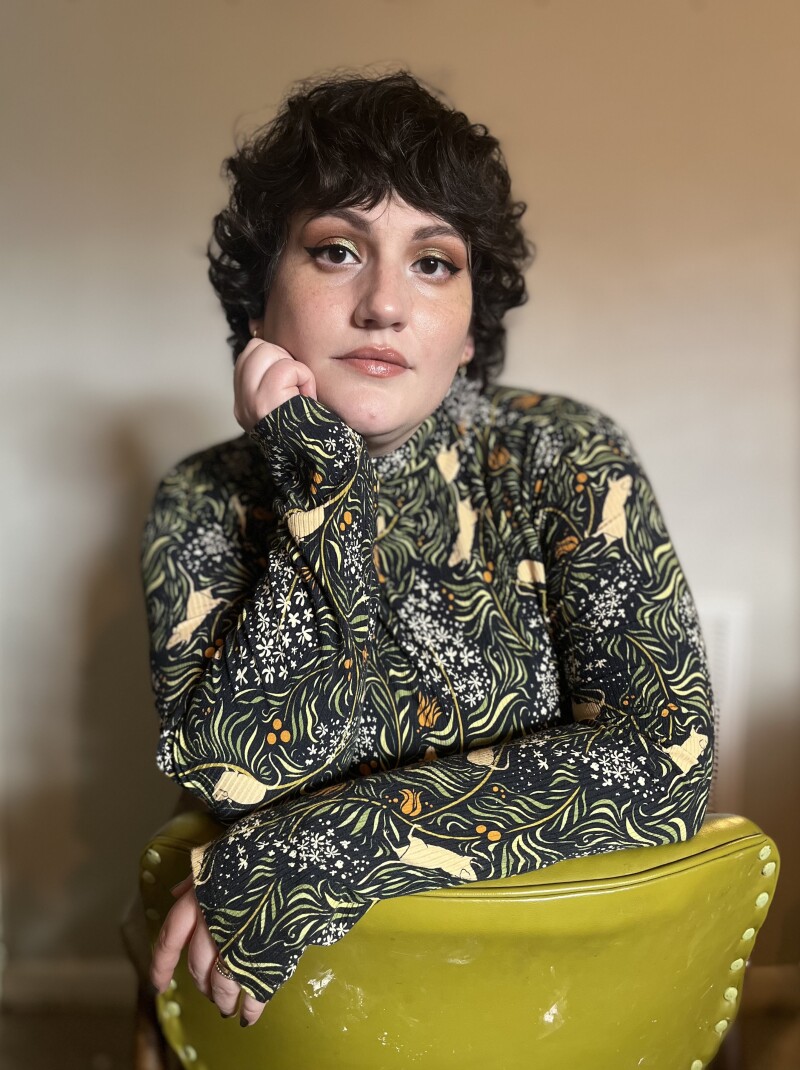
Like Tyrone, Chrisanne values the diversification of religious artwork in helping people to understand the Savior better. Her great-grandfather came to the United States from Mexico, and she prioritizes reflecting her ancestry in her artwork. “I want people to see images of Jesus and see themselves in Him, whether you come from different backgrounds, different ethnicities. I think representation matters.”
Chrisanne hopes that her art communicates the warmth she feels when she thinks or learns about Christ. Coming to know Him through different depictions in visual art can give greater depth to our personal understanding of Christ’s life, mission, and character.
“Sometimes I think of it in terms of trying to render my relationship with Christ in 3D,” Chrisanne says. “So much of my knowledge feels like I have this outline of Christ, or I’m starting to get a little bit of shadowing and lighting … but ultimately, I want to have a full 3D sculpture. And so every experience that is shared about Him—whether that’s my experience or somebody else’s—helps build that image, that relationship.”
Sabrina Squires: Savior of Lilies and Sparrows
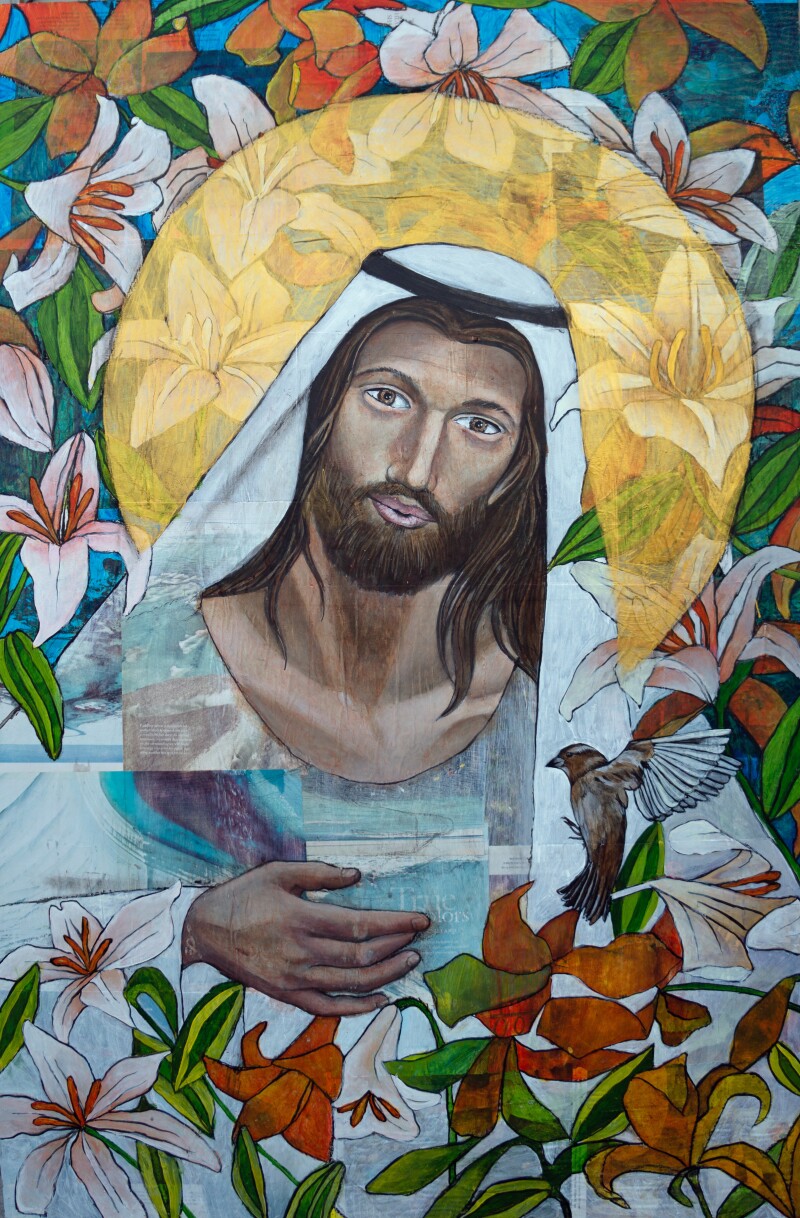
Sabrina Squires also believes in the importance of combining different perspectives to connect with the Savior.
She uses a unique collage style of painting involving mixed media, including altered National Geographic pages, ink, charcoal, and acrylic paint, to mimic textures, colors, and shapes found in the natural world. This approach allows her to explore different dimensions through her art—visually, conceptually, and spiritually.
“[The Savior] can be lots of different things at different times to different people,” Sabrina says. “I work with layers, and it’s a little more abstract, so I use … symbols, patterns, colors, and lots of different levels to represent the Savior.”
Her painting Savior of Lilies and Sparrows focuses on the depth of love that Christ has for all His creations. Sabrina aimed to bring out Christ’s approachable and loving nature in the image, showing Him whistling and beckoning to a sparrow and surrounded by lilies, or “masculine flowers,” as she describes them.
“If He loves the flowers and loves the birds, then He loves us,” Sabrina says. “It paints this beautiful picture of how both masculinity and the priesthood have these aspects of stewardship and caring that I love to focus on.”
Painting the Savior has become a peaceful and almost meditative process for Sabrina, allowing her to focus on Him and His role in her life as a creator, artist, and mentor.
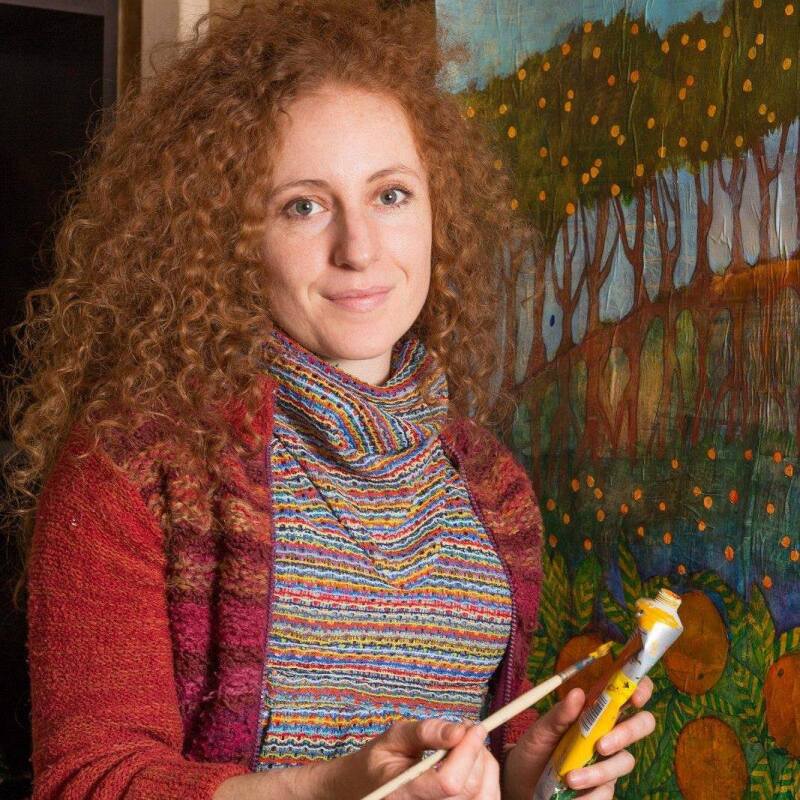
As an art teacher to more than 500 students at a charter school, Sabrina enjoys seeing the creative spirit in all of us—whether while creating art or appreciating others’ work. “I believe we all have parts of godhood in us right now. And when I create, I feel that connection.”
Sabrina feels viewers of art participate in the creative process by bringing their own experiences and perspectives to the painting. For example, she has left words exposed in magazine layers of collage paintings, and people have commented how these details uniquely spoke to them or changed the image’s meaning.
“There’s a certain amount of ambiguity that you have to leave there so people can insert their own experiences,” she says. “A lot of times, it’s not the story that the artist presents [that matters]. It’s the story they see when they look at your piece.”
Ambiguity aside, there is a common message in Sabrina’s paintings of the Savior—her personal testimony.
“There’s so many opinions out there about the Savior, and people connect in so many different ways, and that’s why some people connect with different pieces and different artists. But I’ve found that as I am very true to my experience and how I feel about the Savior, then people connect with that.”
Editor’s note: Sabrina’s art is also featured on the cover of the Book of Mormon 2024 Come, Follow Me Journal Edition.
Greg Olsen: Jesus of Nazareth
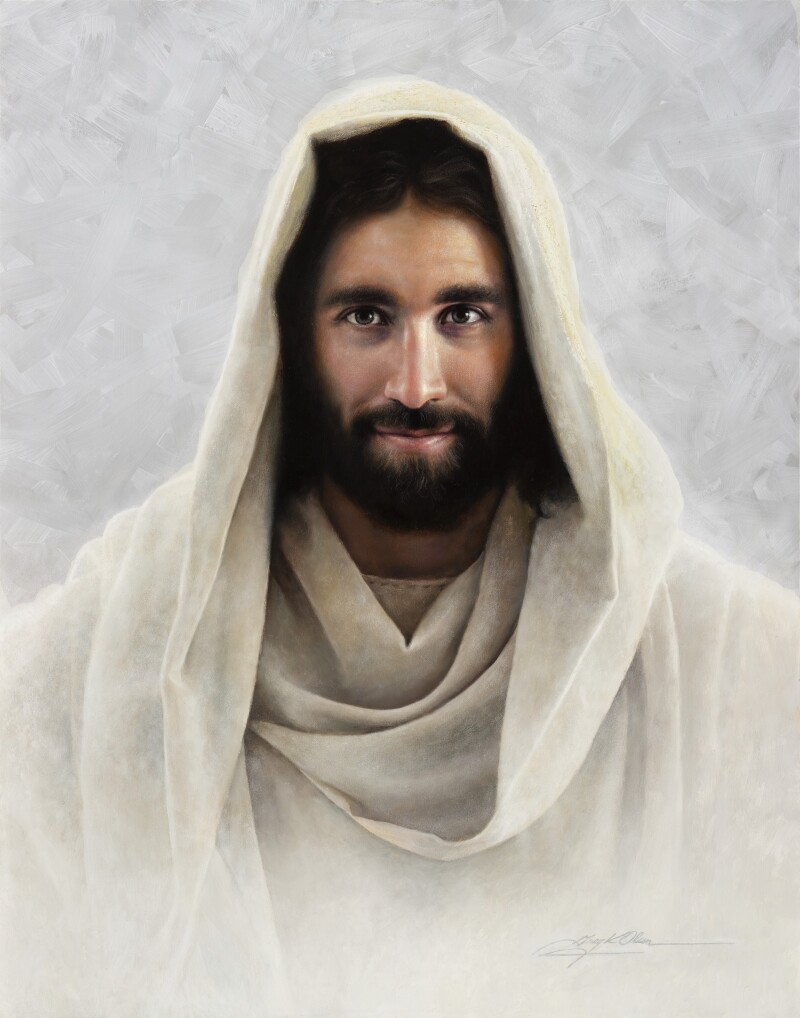
Greg Olsen likewise strives to help others connect with the Savior by expressing his testimony through art. But even after creating over 70 images of Christ, he acknowledges this is no easy feat.
“Painting the Savior’s always been something I’ve been challenged by doing,” Greg says. “It’s a very intimidating subject to attempt because I don’t know how you do it justice.”
His approach has been to focus on different elements of Christ’s character.
“The way that I try to depict the Savior … has more to do with my feelings about Him than His actual physical look,” Greg says. “I’m very conscious of trying to capture a representation of someone who I feel is loving, who’s kind, who’s understanding, who’s accepting.”
To capture these messages and feelings, he spends intentional time reflecting on Christ. A painting might take anywhere from weeks to months, and he says this process requires purposefully slowing down and contemplating.
“It’s like the sacrament prayers say: if we’ll remember Him, we’ll have the Spirit to be with us. And that’s probably been one of the biggest blessings for me, just spending time thinking about, pondering about Him. It’s not a dramatic thing, but it’s a very profound thing for me: just remembering.”
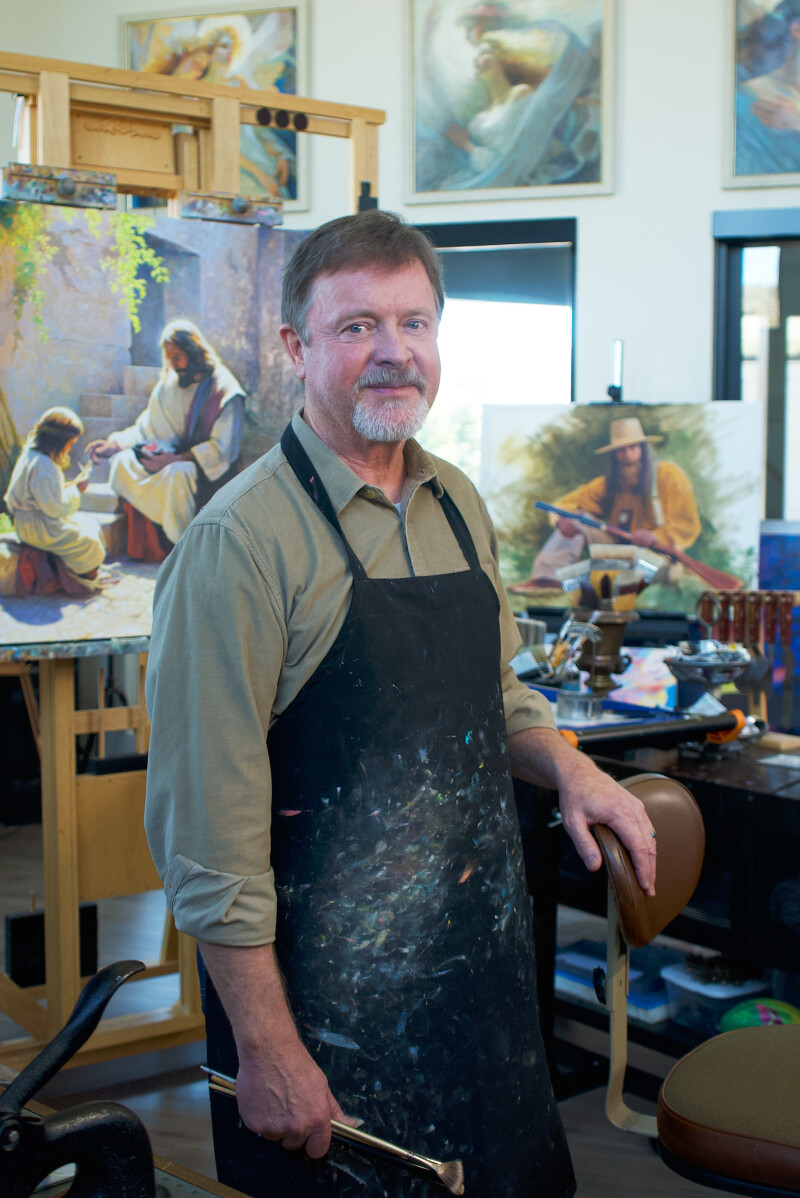
Like Sabrina, Greg finds reflecting on the Savior’s role as a creator particularly intriguing, especially as it relates to our individual journeys to become like Him. He believes each of us has “divine genetics” from our Father in Heaven and Savior that influence our creative potential.
“We’re created in Their likeness, and that means that there’s some part of us that has access to that same thing. We really can be like Them. … Nobody’s exempt from that.”
This inherent shared capacity doesn’t mean that we all need to become artists, either. As Greg says, “It’s so much bigger than that.”
He believes there are infinite ways to express our creativity as forces for good—as a spouse, a friend, a parent, and, ultimately, a disciple of Christ. “It doesn’t have to be something that you perform on a stage or that you hang on a gallery wall. It can just be an interaction with a friend at dinner or taking some time with your kids at home to do something that’s fun and helpful for them.”
▶You may also like: With God, we’ll never run out of good ideas—Greg Olsen’s inspiring take on creativity
Rose Datoc Dall: Light in the Wilderness
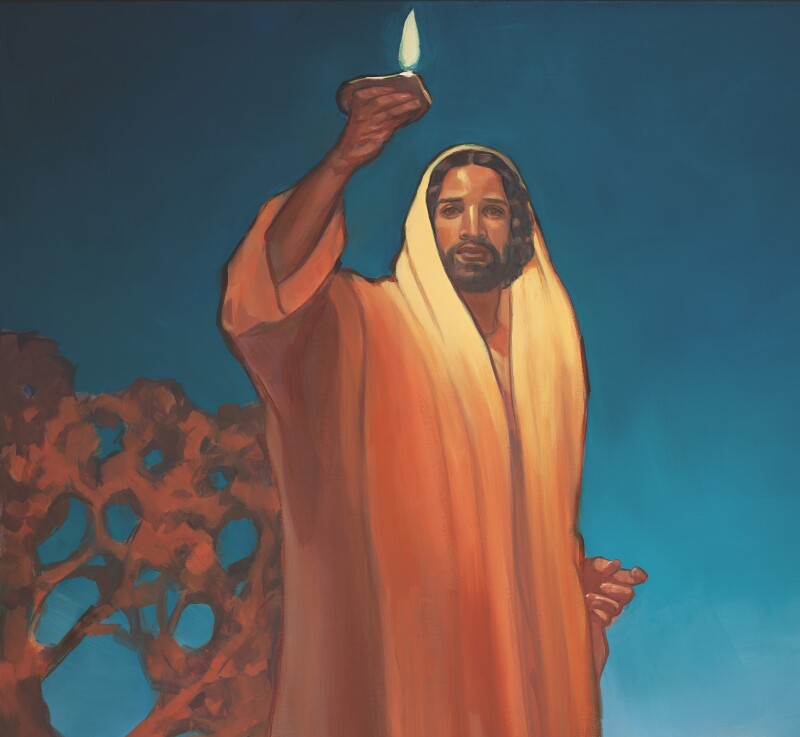
No matter our talents, Rose Datoc Dall believes we’re most creative when we share our gifts.
“The Lord can use our creativity to help others to feel the Spirit,” Rose says. “It’s [also] an opportunity for us to invite the Spirit to be part of the process.”
She feels the Spirit plays a vital role in her creative process, providing glimpses of what final images should look like.
“I’ll see the painting like a flash,” she says. “I can only think that that’s from the Spirit. I usually see the composition, but getting from that to the end product, … there’s usually a struggle involved. There’s a lot of work to do in between, but I am grateful for those little bits of inspiration.”
She appreciates Nephi’s example of faith and creativity in the Book of Mormon when the Lord asked him to build a ship “after the manner which [He did] show [him]” (1 Nephi 17:8). Just as Nephi prayed for guidance in finding the ore and tools to complete the task he’d been shown, Rose believes He helps her act on these flashes of inspiration.
“I feel like the Lord is in those details, and I love that,” Rose says. This doesn’t necessarily mean she expects Him to guide every brushstroke, but she believes He cares about how we respond to promptings and can show us the direction we should take.
Her piece Light in the Wilderness is inspired by the Savior’s reassuring counsel to Nephi: “I will also be your light in the wilderness; and I will prepare the way before you” (1 Nephi 17:13). The painting shows the Savior holding an oil lamp as a beacon of light, symbolizing how we can turn to Him in our own metaphorical wildernesses—whether physical or spiritual.

Rose is fascinated by cinematography and aims to bring a similar visual approach to her paintings, mimicking the compositions and camera angles of film. “Facial expressions are everything in my paintings,” she says. “[In movies,] so much can be told with just … a facial expression, no dialogue. And I’ve always aspired to the simplicity and the directness of that.”
She is especially drawn to stories of the Savior’s compassion and focuses on conveying that Christlike attribute in His demeanor across her work.
“The more that I paint Him, the more I feel His mercy,” Rose says. She has a testimony that we can come to know the Lord better through recording our spiritual impressions and feelings about Him.
“The way that I record my spiritual thoughts is through the images that I create,” Rose says. “It’s like my canvases [and sketchbooks] are my journals. … It keeps me engaged with the Spirit, and it’s a constant reminder to stay in touch with the Savior.”
Whether we feel closer to Christ through creating or appreciating paintings, art can communicate sacred messages through the Spirit and build our testimonies. As we seek to understand and share truths about the Savior’s character, ministry, and mission, we come to see a more vibrant picture of who He is and how He works in our lives—the ultimate Creator of all things (Helaman 14:12).
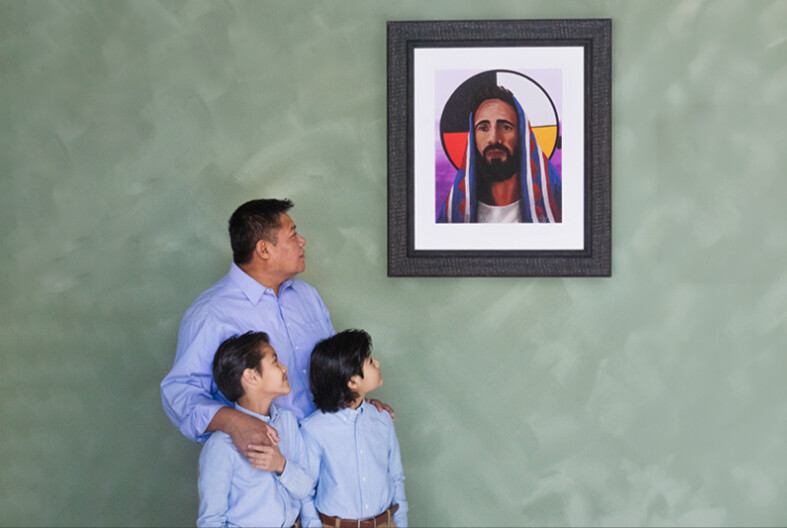
▶You may also like: This Scottish artist shares the Book of Mormon in the most approachable (and adorable) way

